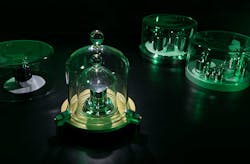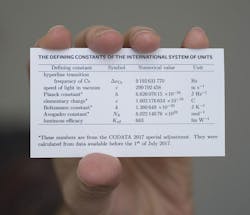Sorry, Primary Kilogram, But We Are Dumping You
In November 2018, in Versailles, France, representatives from the National Institute of Standards and Technologies (NIST) and 60 countries unanimously voted to officially transform the international system of units that underpins global science and commerce. The decades-long quest for a measurement system based entirely on unchanging fundamental properties of nature was officially confirmed for the defining metrology framework used throughout the world. This is the culmination of a larger plan, many years in the making, to define all needed standard values in terms of seven physical constants.
This SI or International System of Units (abbreviated from the French Système international (d'unités)) has seven “base” units such as the second, meter, and kilogram, from which all other measurement units, including the watt and volt, can be derived. These base units define the legal and scientific ultimate meaning of time, distance, mass, electric current, temperature, the amount of a substance, and luminous intensity.
Engineers and scientists know the importance of metrology and primary standards for basic units of time, distance, mass, and more. Decades ago, the second was defined in terms of the Earth’s orbital period (what…it changes a little year-to-year?), the highest-level meter standard was a platinum-iridium bar in Paris with tiny scratch marks (it’s very hard to gauge those, that’s for sure!), and the primary kilogram—called the International Prototype Kilogram (IPK)—was a platinum-iridium cylinder kept in vacuum jar (also in Paris) and only used every few decades to calibrate many secondary kilogram masters (Fig. 1). Complicating its credibility was the verified assessment that this highest-level IPK was apparently losing a few but very precious nanograms every few years, for various unclear reasons.
1. NIST's platinum-iridium kilogram K92 (front), and stainless-steel kilogram masses in the background, are calibrated against the IPK located in Paris. (Source: NIST)
The metrology objective has been to replace these non-reproducible artifacts by definitions that can be replicated anywhere by anyone with the right equipment. The second and the meter have long been defined by fundamental constants of nature, but mass and temperature were still determined by unique master physical objects (the second is a defined as the time for a defined number of a specific atomic energy-level transitions, while the meter is a defined number of wavelengths of a unique optical emission).
But the kilogram evaded being “retired” because there was no way to make an independently reproducible equivalent, and it remained the lone remaining artifact, until recently. Now, decades of worldwide leading-edge R&D bolstered by experimentation and instrumentation finally reached a point when the “master” kilogram has been officially retired and replaced with a reproducible equivalent, as part of a measurement system based entirely on unchanging fundamental properties of nature.
In theory, the seven defining constants (Fig. 2) allow anyone, anywhere, to recreate “perfect” calibration and metrology standards without need for comparison to a master. For example, SI has redefined the kilogram using a fixed value for Planck’s constant and the definition of the meter and second, which are already based on constants. Using these, a mass of any magnitude can be realized by equating the electromagnetic force it takes to hold that mass against the force of gravity using a Kibble balance.
2. What’s in your wallet? This handy card displays the fundamental constants and other physical values that will define a revised international system of units and can help resolve any immediate metrology issues. (Source: NIST)
This instrument uses the fundamental E = mc2 relationship between mass and energy, along with the extremely accurate value for Planck’s constant (which relates a photon’s energy to its frequency). Scientists and engineers can now relax, knowing that they can achieve the extraordinary accuracy they need for mass measurements without checking their “master” kilogram at NIST or at similar measurement institutes at other countries.
The replacement of the master kilogram as an artifact with a reproducible primary standard represents the culmination of a long-sought dream of metrology experts. Now, none of the defining constants and primary standards are tied to a single physical artifact that could be damaged, lost, stolen, or even changed over time for uncontrolled reasons, as the IPK and Earth’s orbit have been doing.
Perhaps in the near future, someone will come across that previously sacrosanct master kilogram casually tossed into a pile at a local flea market and wonder what this cylinder was actually used for, as a scene in a dystopian or futuristic science-fiction story. You never know…it’s not inconceivable.
References
“For All Times, For All Peoples: How Replacing the Kilogram Empowers Industry”
“A Turning Point for Humanity: Redefining the World’s Measurement System”
“Toward the SI System Based on Fundamental Constants: Weighing the Electron”



